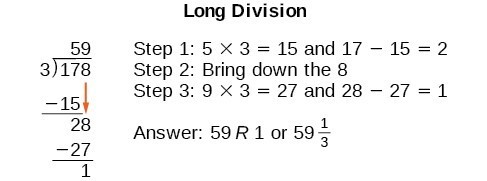Polynomial Long Division
Learning Outcomes
- Use long division to divide polynomials.
recall long division
A handy algebraic technique involves rewriting a quotient of polynomials as a polynomial of reduced degree plus a remainder quotient.
Or equivalently by multiplying both sides by ,
This method is akin to rewriting an "improper" fraction such as
.
Or equivalently,.
The process used to accomplish this is similar to long division of whole numbers, so if you haven't performed long division for awhile, take a moment to refresh before reading this section.
Answer:
Recall how you can use long division to divide two whole numbers, say divided by .
![]() First, you would think about how many are in , as is too small. (Note: you could also think, how many are there in .)
There are two in , so write above the last digit of . Two is ; write that product below the .
First, you would think about how many are in , as is too small. (Note: you could also think, how many are there in .)
There are two in , so write above the last digit of . Two is ; write that product below the .
 Subtract: is . (If the result is larger than the divisor, , then you need to use a larger number for the quotient.)
Subtract: is . (If the result is larger than the divisor, , then you need to use a larger number for the quotient.)
 Bring down the next digit and consider how many are in .
Bring down the next digit and consider how many are in .
 There are four in , so write the next to the two in the quotient. Four is ; write that product below the .
There are four in , so write the next to the two in the quotient. Four is ; write that product below the .
 Subtract: is . This is less than so the is correct. Since there are no more digits in the dividend to bring down, you are done.
Subtract: is . This is less than so the is correct. Since there are no more digits in the dividend to bring down, you are done.
 The final answer is R, or . You can check this by multiplying the quotient (without the remainder) by the divisor, and then adding in the remainder. The result should be the dividend:
The final answer is R, or . You can check this by multiplying the quotient (without the remainder) by the divisor, and then adding in the remainder. The result should be the dividend:
 Another way to look at the solution is as a sum of parts. This should look familiar, since it is the same method used to check division in elementary arithmetic.
Another way to look at the solution is as a sum of parts. This should look familiar, since it is the same method used to check division in elementary arithmetic.
We call this the Division Algorithm and will discuss it more formally after looking at an example. Division of polynomials that contain more than one term has similarities to long division of whole numbers. We can write a polynomial dividend as the product of the divisor and the quotient added to the remainder. The terms of the polynomial division correspond to the digits (and place values) of the whole number division. This method allows us to divide two polynomials. For example, if we were to divide by using the long division algorithm, it would look like this:
 We have found
We have found
or
We can identify the dividend, divisor, quotient, and remainder.
 Writing the result in this manner illustrates the Division Algorithm.
Writing the result in this manner illustrates the Division Algorithm.
A General Note: The Division Algorithm
The Division Algorithm states that given a polynomial dividend and a non-zero polynomial divisor where the degree of is less than or equal to the degree of , there exist unique polynomials and such thatis the quotient and is the remainder. The remainder is either equal to zero or has degree strictly less than . If , then divides evenly into . This means that both and are factors of .
How To: Given a polynomial and a binomial, use long division to divide the polynomial by the binomial
- Set up the division problem.
- Determine the first term of the quotient by dividing the leading term of the dividend by the leading term of the divisor.
- Multiply the answer by the divisor and write it below the like terms of the dividend.
- Subtract the bottom binomial from the terms above it.
- Bring down the next term of the dividend.
- Repeat steps 2–5 until reaching the last term of the dividend.
- If the remainder is non-zero, express as a fraction using the divisor as the denominator.
Example: Using Long Division to Divide a Second-Degree Polynomial
Divide by .Answer:
 The quotient is . The remainder is 0. We write the result as
The quotient is . The remainder is 0. We write the result as
or
Analysis of the Solution
This division problem had a remainder of 0. This tells us that the dividend is divided evenly by the divisor and that the divisor is a factor of the dividend.Example: Using Long Division to Divide a Third-Degree Polynomial
Divide by .Answer:
 There is a remainder of 1. We can express the result as:
There is a remainder of 1. We can express the result as:
Analysis of the Solution
We can check our work by using the Division Algorithm to rewrite the solution then multiplying. Notice, as we write our result,- the dividend is
- the divisor is
- the quotient is
- the remainder is 1
Try It
Divide by .Answer:
[ohm_question]29482[/ohm_question]